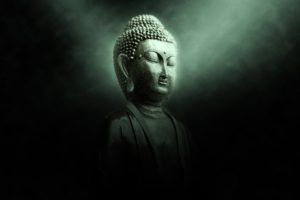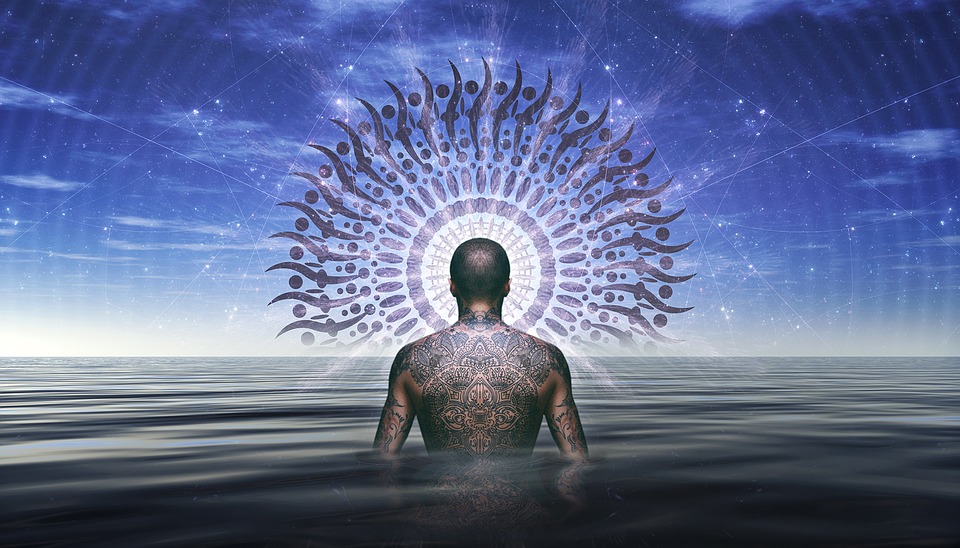Buddha realized that in order to explain and guide people out of suffering and toward enlightenment he must rely upon explaining common human truths in our world that could be seen, recognized and then understood by all. This is one of the reasons why 2500 years later in a completely different time and civilization we can still see these evident common human truths.
One of these truths is how the experience of self arises even though there is no self, we create a false sense of a present fixed self that is only based on our experiences and memories. Thus we fail to see that there is no fixed self and that the world around us is an illusion in a temporary state of creation, this is called Ignorance in Buddhism a failure or unwillingness to understand the true nature of existence.
Dependent Origination and its twelve links form an intrinsic part of Buddha’s teachings of which Ignorance is the first link.
He saw Ignorance as the fundamental cause of suffering and the first event in a linked chain of events, each event occurring as a result of the previous event. Being Ignorant creates all the suffering and happiness in our lives and is part of the experience of Samsara or the Wheel of Karma. Because we are ignoring the true causes of our suffering or happiness we can’t see or understand the true reality of our existence we are trapped in Samsara with its good times and bad times. 
By ignoring the true nature of our reality, we project things that do not exist, we are deluded and confused, and we project and protect a sense of self because we are under the illusion that the permanent self exists. Even though all things are temporary we project permanence, a belief that our house or car or even our bodies are permanent, yet houses will crumble, cars will rust, bodies will get sick and die. So it is with our sense of self, we believe it is a permanent thing but it is very temporary, we are all in a state of constant change, that self you believe is you, arises a different self each morning and changes with each experience of the day. Our Ignorance gives rise to this delusion and confusion and because of this confusion our personal world of Samsara is created.
All the ways in which we relate to our selves and the world around us are created by our own causes of Ignorance.
But this can be a good thing because ignorance can be relieved by understanding and realization, if Samsara and your sense of self were truly sold and permanent then neither you nor the world could or would ever change. Change is a universal constant and therefore all things including your sense of self are impermanent, temporary and constantly changing. This gives rise to the possibility of seeing your ignorance at its roots and thereby coming to understand your mind and the true nature of Samsara. If you see then you can remove the cause of ignorance and become liberated from Samsara which is wholly dependant on your delusions of ignorance.
 A prime example of Ignorance used in Buddhist teaching is this; you walk into a dark room, in the corner you notice and can just see make out something coiled, out of ignorance you jump to the conclusion that it might be a snake, you experience immediate fear and anxiety and other obscuring emotions that cloud your mind. When you turn on the light, you see it is a coiled rope; and this is how ignorance the root of suffering works. We jump to conclusions out of the darkness of ignorance and experience negative thoughts, emotions, and actions; maybe we beat the rope to death before turning on the light.
A prime example of Ignorance used in Buddhist teaching is this; you walk into a dark room, in the corner you notice and can just see make out something coiled, out of ignorance you jump to the conclusion that it might be a snake, you experience immediate fear and anxiety and other obscuring emotions that cloud your mind. When you turn on the light, you see it is a coiled rope; and this is how ignorance the root of suffering works. We jump to conclusions out of the darkness of ignorance and experience negative thoughts, emotions, and actions; maybe we beat the rope to death before turning on the light.
To help accept and understand that our seemingly solid unchanging self is actually a mercurial constantly changing no-self, Buddha taught three subsequent vehicles of understanding and transformation, the Hinayana, Mahayana, and Vajrayana. Each with a progressively deeper understanding and realizations, that would bring about the understanding of the true empty nature of the universe and therefore our false sense of self that is also empty in nature or a no-self.
When we try to define our individual selves or me, there is no one thing that we can actually call or name as our I. Just like the universe is a collection of elements that may temporarily combine to form a rock or tree, but rocks crumble and trees die and break down back into elements that become the earth from which they came, nothing truly exists on its own, everything is reliant on a temporary combination of elements to give it form. The I/you were yesterday, is not the I/you think you are today, nor will it be tomorrow. This projection of a permanent I is an illusion, a false assembly of constantly changing elements to make up a whole I, and give you the ignorant sense of a permanent non-changing individual self.
On a common basic level, we use our mind as a single thing that exists and experiences, feeling and perceptions.
This is a very powerful experience we feel utterly sure that the mind exists as a solid entity. But once you begin to look closer and examine its very nature or essence, you will discover that mind is devoid of any such entity. The mind has no color or shape, nor does it rest anywhere, the thing we call the mind is nothing at all and can be found nowhere, thus the very essence of the mind is emptiness and has no form shape or color.
You can overcome this false projection of a permanent self, and if you can remove this ignorance, the root of suffering and understand and realize the empty nature of the universe. This will bring the realization that you still actually do exist even without your thoughts and ego or I. And this is one of the major steps in breaking free from a conditioned existence in the self-created cycles of Samsara.





